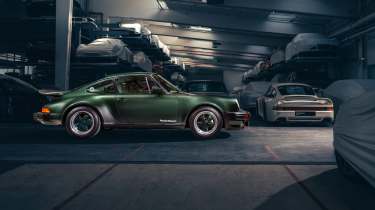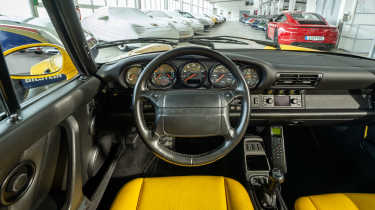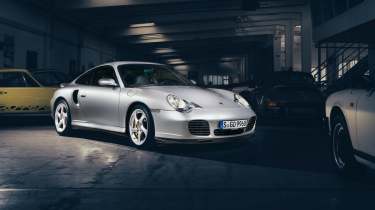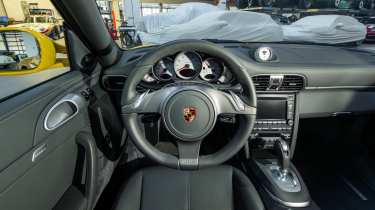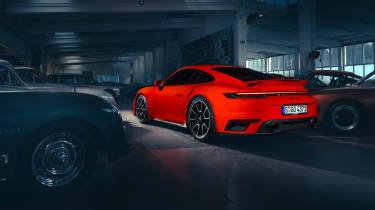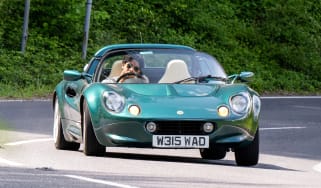Porsche 911 Turbo: 50 years of a supercar icon
Fifty years ago Porsche changed the performance car world forever with the launch of the 911 Turbo. Adam Towler tells its remarkable story
Simply ‘Turbo’ suffices. We all know it means ‘Porsche 911 Turbo’. Always has, always will. The flagship of the 911 range; the sensible, bargain supercar. As the 50th anniversary of the model is now upon us, there’s no better time to look at why the 911 Turbo changed the face of performance motoring, and what it meant and still means, not just as a car but to the company that created it and the industry as a whole.
Porsche wasn’t quite the first, of course. GM had shown that turbocharging could work in a road car as far back as 1962, and while Porsche had been running a 2-litre turbo ‘six’ on the dyno as early as 1969, BMW claimed Europe’s first turbocharged production car with its 2002 Turbo in 1973. In truth a number of factors – and a healthy dose of Germanic pragmatism – coincided to bring Porsche’s most famous model line to life.
> Porsche 911 S/T 2024 review – the 992 in its purest, most involving form
The first was that it had a new man in charge in the form of Dr Ernst Fuhrmann. After the bickering that had threatened to tear the company apart, the family had decided to take a step backwards, and Porsche’s first CEO was appointed at the beginning of 1972. A small man with strong leadership skills, a fiery temper and a slightly odd tendency towards superstition, Furhmann was a former Porsche engineer who also saw the value of motorsport. The company had spent a vast amount on winning Le Mans with the 917 – and then the Can-Am series with the turbocharged version – and while the purse-strings had now been tightened considerably in a harsher economic landscape, surely that new turbocharging know-how and marketing gold could be put to good use? Moreover, the boss also liked fast cars, and he wanted his engineers to build him one.
He decreed that the turbocharger was the way forward, and engineer Valentin Schäffer duly started work on a 2.7-litre turbocharged flat-six influenced by the 1000bhp-plus Can-Am racers. By the spring of ’73 it was taking its first hesitant steps around the Weissach test track, and at the 1973 Frankfurt motor show a silver 911 appeared on Porsche’s stand. Ostensibly a 3.0RS in looks, but with funky ‘Turbo’ graphics, the official line was that it featured a 2.7-litre turbocharged engine offering 280 PS (276bhp), enabling a 160mph-plus top speed. Interest, understandably, was high. This was in spite of it being an appalling time to consider such a vehicle, given the world was in the midst of the OPEC oil crisis, with speed limits hastily implemented and rocketing fuel prices. Launching such a car would be an enormous risk, and the project – with the self-proclaimed mission of defeating turbo lag – was proving extremely costly.
From this point, the ‘Mission Turbo’ split in two directions. The racing department prepared a featherweight prototype Turbo RSR, using a 2.1-litre turbocharged engine good for up to 500bhp. A data-gathering exercise for one year only, it nevertheless came home second at that year’s Le Mans 24 Hours. And then there was the road car, a homologation special since new rules for 1976 meant 400 Turbos would need to be sold within a two-year period if the car was to be eligible for the new Group 4 GT and Group 5 silhouette formulas.
There were arguments over price and what sort of car it should be: some favoured a less expensive car, stripped out and more like a turbocharged RS; others, Fuhrmann included, saw a luxury flagship, quiet but very fast – and expensive. The doctor and his colleagues won, and in doing so established the overall character of the 911 Turbo that holds true to this day.
That silver car hadn’t been a runner, but by the Paris show of 1974 the finished article (under type number 930) was ready, and it was quite some car. The engine had grown to 3 litres, as the larger displacement helped counter the chronic turbo lag from the single KKK 3LDZ turbocharger, but worried about how demanding to drive the car might be for its customers, Porsche had been conservative. The new engine was given a low compression ratio and rated at just 260 PS (256bhp), although that was 30 PS above the naturally aspirated flat-six in the new 3.0 RS, and connected to a four-speed manual gearbox as there were concerns that the existing five-speed ’box would not be able to handle the torque.
Talking of which, it was the sturdy 254lb ft of pulling power that would make the new Turbo such a devastatingly rapid car, even at a maximum boost of only 0.8 bar. Not that the driver would know about that, since Porsche had omitted to fit a boost gauge. Under the seductively widened rear arches were 15in alloys with 16-inchers as an option (soon to be made standard), while out back was an extraordinary new aerodynamic device: the soon-to-be-famous ‘whale tail’ rear wing.
The often-overlooked fact about this sensational, ground-breaking new car was how – relatively speaking – light it was. In particular, the first year of the 3-litre model didn’t have air-conditioning as standard, and had less sound-proofing, too, contributing to a kerb weight of just 1140kg. Which means the car has more than a little of the feel of a contemporary RS Touring, with a lightness of touch to the steering once on the move and real delicacy to its handling. Fast, fun and oozing charisma in 2024, in 1974 it must have felt like an alien craft.
The Oak Green example here at the Porsche Museum (previous pages) deserves special mention. First registered on 23 September 1976 to Ferry Porsche, the great man unsurprisingly had fine taste, teaming the exterior with light green Buffalo leather and ‘Tartan Dress Black Watch’ seat inserts. Typically, there were many subtle refinements for this third and final year of 3-litre production, including the fitment of a boost gauge.
For the 1978 model year, Porsche unveiled its first major update of the Turbo, and it was this model – the 3.3-litre Turbo – that would go on to have an extraordinarily long lifespan, right up until 1989. The key change was not just the increase in displacement, but also the fitment of an intercooler, which necessitated the switch from the ‘whale tail’ to the ‘tea tray’ rear spoiler, with its curved upwards lip. Producing 300 PS (296bhp) and 302lb ft (rising to 319lb ft on later models), these are the original monster Turbos – a purely analogue driving machine, with the power to take on any supercar from the period. The increased weight of the engine package and a stronger, quieter clutch that pushed the engine further backwards in the chassis make driving one of these 930s quickly an expert-level challenge. It was only in the final year of production that Porsche got around to fitting a five-speed ’box, but that was largely due to Weissach being busy with a number of other key projects, some of which weren’t going so well…
Looking at our next car, the 964 Turbo 3.6 below, it’s hard to conceive that it came about as a last-minute stop-gap. Of all the Turbos we have gathered in the bowls of Porsche’s storage facility, it is – to my eyes at any rate – the X-rated one: a perfect blend of tight, compact, original 911 with modernised looks and updated technology for a brilliant mix of analogue interaction and raw pace. The last of the monsters with rear-wheel drive and a single large turbocharger, it’s the car made immortal in the Hollywood blockbuster Bad Boys. Honestly, I just can’t take my eyes off it wherever I am in the room.
However, the reason Porsche’s dealers had been saying the last of the five-speed 930s marked the end of an era was simple: its intended replacement would be an altogether different car, something more akin to a little brother of the 959 supercar rather than merely a 911 with higher performance. Given the green light in 1984 alongside the heavily revised 911 that was to be known as the 964, the 965 would be sold as the ‘Porsche 969’ and the specification was indeed truly mouth-watering.
At its heart it consisted of an air-cooled 3.3-litre flat-six topped with water-cooled, double-overhead-cam cylinder heads (like the 959 and Porsche’s Group C racing cars of the period) and projected to produce around 375bhp, with four-wheel drive and a new air suspension system that would be standard on the 969 and optional on 964 Carreras. The body adopted the rounded, pebble-smooth surfacing of the 959, with laid-back headlamps and an integrated ‘handle’ of a rear wing, sculpted to provide aerodynamic stability for the car’s 185mph-plus top speed. Throughout the ’80s the engineers worked away at the 965, but by 1988 there was a major problem brewing, and it was the beginning of a perfect storm on multiple fronts that nearly brought Porsche the company to its knees.
The 969 simply wasn’t working. The engine didn’t produce the power and was suffering from overheating, while Porsche’s finances were now distinctly undercooked. Change came rapidly at the top, but one CEO gave way to another and still the sales continued to freefall as the world economic situation deteriorated. Key personalities of the old guard left, and there was a desperation to save money after massive investment in technology and production facilities couldn’t be supported by an ageing and thin product line-up. Even the racing went sour, with the failure of the hugely costly IndyCar project, Group C sportscars overwhelmed, and perhaps worst of all, the humiliation of a disastrous F1 engine programme. By the end of the year the 965 was gone for good, all bar one of the 16 prototypes, nicknamed the ‘Black Bomber’, destroyed.
Yet Porsche needed a Turbo, and at this precarious point in its history, more than ever. The Turbo gave the model range pomp and delivered that juicy profit margin so desperately needed to keep the company afloat.
The solution was simply to turbocharge the 964-series 911 using the tried and trusted 3.3-litre engine from the 930, but upgraded to run with catalytic converters for worldwide homologation. Still using the old K-Jetronic Bosch injection for reasons of cost, and with a single blower, it now made 320bhp and 332lb ft of torque, delivering drive through the five-speed G50 ’box debuted on the last of the 930s. It also had power steering, ABS, coil springs and all the other updates of the 964 series. Sales began at the end of 1990 at £74,580, and the result was a muscle-bound thug of a car: heavier, longer-geared and with wincing thirst (around 11mpg!), it nevertheless hit the spot. For 1993, Porsche went a step further, retaining the single turbocharger set-up but basing the engine on the 964’s M64 3.6-litre engine, and fitting 18in split-rim Speedline alloys.
The yellow 3.6 on the previous pages, with its wonderfully period and Germanic matching yellow leather interior, is arguably the ultimate expression of the original 1974 Turbo idea. In a post-Honda NSX supercar landscape, it wasn’t hard to pick holes in a Turbo 3.6, but even to stand next to it is to feel a rush of delirious excitement. It’s not an easy car to tame, but let’s be honest: we all want to give it a try…
What next for Porsche’s perennial supercar? With credible rivals from Japan now a reality and Ferrari in the midst of a significant renaissance under Luca di Montezemolo that was soon to bear fruit with the glorious F355, Porsche had to update the Turbo recipe rapidly to maintain relevance. Happily for the men from Stuttgart, things were very much on the up.
Firstly, there was finally someone in charge who really understood the premium automotive business. That man was Wendelin Wiedeking, and while many today associate him with Porsche’s calamitous financial dealings that led to the VW takeover in 2009, it was his astute and determined leadership that effectively rescued the company, turning it around to the point where it nearly took over the world’s largest carmaker. Meanwhile, by 1994 Porsche had the new 993 in production. The final chapter in the history of the original air-cooled 911, the 993 introduced a new multi-link rear axle, while its new, rounded look captured the performance car zeitgeist. Suddenly, Porsche’s sales were climbing again.
The 993 Turbo (pictured below) was everything the ill-fated 969 should have been and more. Now the engineers were able to finally modernise the air-cooled flat-six, utilising two turbos, one for each bank of cylinders, and the latest Bosch engine management. Coupled to a new six-speed gearbox and adhering to the new policy of four-wheel drive for models with more than 400bhp, the 993 Turbo offered 408bhp and simply massive point-to-point performance. With powerful brakes and heavily revised aerodynamics, here was the Turbo that reinterpreted what the nameplate stood for: all-weather ability now joined the list of time-served attributes, and fear took a step backwards.
The magical thing about a 993 Turbo is how, even today, it still feels so fast and capable. It’s an effortless sort of car – too much so, said a few traditionalists at the time, as they usually do – and one that’s devoid of the turbo lag that had always blighted and deeply characterised its forebears, and with so much more stability and security on the road. No longer was driving the Turbo quickly a multi-level game of chess; rather it was the sort of car that almost anyone could go exceedingly fast in, relatively easily. Even so, just standing behind one when it’s idling is enough to sense what a beast it is: the exhaust note is deep, rich and thick enough to carve with a cake slice.
John Barker attended the press launch in the south of France, memorably shot by Peter Robain for the cover of Performance Car with a Rivera Blue example. John soon discovered just how monstrously quick the new car was: ‘I found myself confronted by a long straight and nailed it. At the end was a corner, and I’d pulled enough of a gap over Pete in the hire car to park up after it, climb out and light a cigarette before he appeared…’ Later, Robain’s camera bag was flung out of the rear seat, across to the other side of the cabin and emptied onto the floor. ‘It was a sign of just how much grip the new car had,’ laughs John today. ‘It wasn’t a widow maker any more. Years later, Dickie Meaden and I put a 993 Turbo up against a 959 back in the UK: the 993 didn’t quite have the explosive delivery of the 959, but to drive it made the older car feel quite soft and unfocused…’
If the 993 was a radical repositioning of the 911 Turbo sub-brand, what came next was an even greater and more controversial shift. In making it, Porsche created the template for everything that has followed over the subsequent 25 years, for it’s easy to plot the progression from 996 to 992 Turbo. Bigger, heavier, more powerful and faster, yes, but still cars with a clearly defined lineage.
Newly confident and flush after the success of the 986 Boxster and the 993 and 996 versions of the 911, Porsche sought to apply its latest thinking to the Turbo. There was a new, water-cooled engine, distinct from the one used in the Carrera models, that in time would come to be nicknamed the ‘Mezger’ after the legendary Porsche engineer Hans Mezger. Dear Hans hadn’t designed the new twin-turbo, 3.6-litre, quad-cam flat-six, but the block used could trace its roots back to Porsche’s racing engines of the late 1970s, so that was enough for most. Although it offered only a little more power than the 993-based car (414bhp plays 408bhp), it was cleaner, quieter and generally more advanced, in line with the lighter, more slippery bodyshell it was inserted into. The result was a triumph, the 996 Turbo claiming the eCoty crown in 2000 and rightfully earning its spot in the Porsche hall of fame.
As a then-young road tester on a motoring weekly, this was the first Turbo I could get my hands on, and I still remember the afternoon, some 20 years ago now, like it was yesterday. It was Speed Yellow, had the X50 kit taking it to 444bhp, and simply holding the keys made my heart thump almost audibly in my chest. For a minute or two the fact that it was so easy and effortless to drive stole my thoughts, but that instantly turned to sheer incredulity when I opened it up for the first time. Had you been alongside, in that passenger seat, you would have heard the shrieking of a madman over the whistle and growl of the engine as the Turbo seemed to wheelie to the horizon on an unending and towering wave of acceleration that crushed time and space and made virtually any overtake seem absurdly easy. The speeds were unprintable and then, just as quickly, when the road changed it became docile and easy again, only the fabulously sinister rumble of the Mezger engine the giveaway to those in the know that extraordinary power lurked nearby. Rarely have I ever wanted a car as much as that custard-hued beast from Stuttgart; it seemed like alchemy on four wheels.
However, something that wasn’t necessarily understood at the time was that the Turbo was now under threat. Not from a rival car maker or a legislative body, but an enemy within: the 911 GT3. Just months before the latest Turbo’s unveiling, Porsche had launched its motorsport homologation car; in fact, the GT3 owed its high-revving Mezger engine to the Turbo, because it was the economies of scale from Turbo production (they share the same block) that made the project feasible, as opposed to an updated M96 Carrera unit that had been slated for the road-racer. Now, akin to some Greek tragedy, the GT3 would in time bite the hand that had fed it.
‘The Turbo was always The One,’ says Dickie Meaden. ‘It had that reputation, for good and for bad. But the 996 Turbo coincided with the RS model coming back [now in the form of a GT3], and ultimately, on the track at any rate, the Turbo wasn’t as resolved.’ For now, this wouldn’t be a problem – Pferde for courses, as they say in Flacht, probably – but in time it would have a big impact on the direction of the Turbo line.
All of which brings us to the 997. If the 964 possessed the last of the original Turbo ethos, then the 997.1 marks the end of Act 2. Here Porsche finessed its water-cooled creation, improving the interior, the driving position, incorporating a more traditional aesthetic that majored on the curves of the past, and extending the Mezger to a thumping 473bhp. Variable-vane turbochargers sought to improve the response from the engine, but their ability to rapidly build boost actually gave the car more than a little of the old-school whizz-bang excitement. For its footprint, general size, characterful engine, manual ’box and the way it looks, this will always be my favourite 911 Turbo.
Henry Catchpole agrees: ‘The 997.1 is the favourite of those I’ve driven. Early cars are a bit lairy and scary, the next ones have a reputation for not as much involvement, but the 997 had ridiculous pace and was so fun, too.’
The yellow car pictured above is actually a second-generation 997, which marked the beginning of a shift towards new technology. There was an all-new engine for a start, the Mezger being pensioned off in favour of the MA1 engine featuring direct fuel injection, with displacement, power and torque rising to 3.8 litres, 493bhp and 480lb ft respectively (the later S would boast a staggering 523bhp). Another debut was the PDK twin-clutch transmission: the old Tiptronic torque converter had always been a popular option on the Turbo, to the detriment of its outright driver appeal, but now here was a gearbox that offered both improvements in economy and also a significant step up in performance, with 0-62mph quoted as just 3.4sec. A manual ’box was still available – for now. It would be the last.
What Porsche hadn’t reckoned with was the arrival of an extraordinary new Nissan that not only set new standards for performance, and at a price that was frankly a steal, but whose creators seemed intent on invading Porsche’s home turf, namely the Nürburgring Nordschleife. Whatever the tyre compounds involved, there was no doubt that the GT-R put the wind up Porsche, with major ramifications for the future. The 997 could feel a little soft on circuit, a little wayward under weight transfer, and such sensations would soon be a thing of the past.
Stuttgart came back with vengeance in 2013 with the 991 Turbo. The bigger, heavier new Turbo S boasted 552bhp and 553lb ft (on overboost) but much more besides: PDK, rear-wheel steering, torque vectoring, active anti-roll bars, active aerodynamics, active engine mounts… By now the 0-62mph time was listed as just 3.1sec, although as any seasoned Turbo pilot knows, the reality is much quicker than that on most surfaces and in most conditions (on the 992.2 launch, Porsche engineers revealed that the Turbo S would record 2.6sec repeatedly without complaint).
‘It has the terrifying relentlessness that has come to characterise the breed since it went four-wheel drive with the 993,’ wrote Jethro Bovingdon at the car’s launch drive. It left him nearly speechless on the track, but on the road he found it slightly aloof and unresponsive at times and lamented that its real thrills were efficiently disguised. It was clear that the Turbo had more than enough of the good stuff to take its place in the lineage of greats, but perhaps by chasing performance and lap times Porsche had forgotten about character and drama at saner speeds…
For the first time, Porsche fielded a two-tier model range from the start, recognising not so much that there were those looking for a bargain Turbo model, but rather that the sheer power and capability of the car meant that in a now credit-fed market the price point could be stretched upwards, with most opting for the S model to the benefit of profit. In fact, the 513bhp ‘regular’ Turbo was a sweeter car in many ways, particularly without the active anti-roll bars that did much to stifle a sense of connection in the S. That said, with the advancements in infotainment and a notable reduction in the road roar that was always an Achilles’ heel of the 996/997 models, the new car was even better at being an everyday companion.
With the 991.2 those mighty power outputs rose to 533bhp and 572bhp, although the chassis was largely unchanged. Once again the biggest threat to the Turbo’s star quality became the 911 GT3, though getting the latter entailed all sorts of tricks and status, while the Turbo quietly continued in the background, available to order to any walk-in customer.
All of which takes us to the Lava Orange 992 Turbo S with us here today. The recipe is similar to that of the 991 – the engine is fundamentally the same, although when evo joined then-sports cars head Dr Frank Walliser on a development drive (evo 268) he made it clear that a high proportion of the work had been in making such an engine pass noise and emissions laws in the first place. We were, it seemed, lucky to have a Turbo at all.
There’s a fundamental and sometimes overlooked truth about the modern-era Turbo, especially the 992 Turbo S. On a track it’s spectacularly capable. You sense it’s not the sort of thing Porsche actively shouts about, simply because it sits rather uncomfortably alongside all those lusted-after GT models, but evo has recorded some staggering lap times with the Turbo S and moreover, once done, there’s the ability to drive home in quiet, unfussed comfort. Quite simply, the majority of drivers would be faster in a Turbo S than a GT3.
Wildly desirable, though? For me, it doesn’t quite hit the spot – witness it coming last in eCoty 2020, where it failed to really get under the skins of our testing party. The Turbo has become so good that you barely scratch the surface on the road, which inevitably means you don’t really get to know the car. And while it’s a visually impressive car up close, here today amongst the handsome ones like the 930, the 964, or frankly any of the earlier cars, the 992 lacks their compact sports-car-on-steroids proportions and their mesmerising curves.
With the broadening of Porsche’s product portfolio post-millennium, ‘Turbo’ has become more than just about blown 911s. First, there were the legitimate uses, the turbocharged V8s in the Cayenne, and latterly the Panamera. Here, unquestionably, the Turbo was the flagship (unless it was the Turbo S, naturally). Then came the Macan Turbo – a subtle distinction, because all Macans were turbocharged, but the flagship was more ‘Turbo’ than ‘turbo’. That marketing ‘stretch’ became more pronounced with the arrival of the 991.2 Carreras, which adopted a turbocharged 3-litre engine, making all 911s outside of the GT department turbocharged. Now it really was a case of ‘t’ and ‘T’ and the case for the Turbo looked diminished, at least on paper: a drive usually sorted that out. However, lately the Turbo has really outgrown its specific meaning with Porsche’s EV offerings, where ‘Turbo’ has been applied purely as a marketing term based on its historical value and brand equity. Does this matter? After all, most people, beyond merely car enthusiasts, recognise that Porsche and Turbo mean the fastest model of all.
So, after 50 years the Turbo remains in rude health. Its story arc is a fascinating one, and the fact that it has simultaneously morphed in different directions and stayed true to its roots is quite some feat in itself. With our time with the museum’s cars complete, there’s a solitary hour to venture out onto the autobahn in a 992 Turbo S – well you would, wouldn’t you? That boost can’t be ignored. Traffic blunts my quest to go for V‑max, but the brief opportunity that presents itself proves just how hugely fast the latest car is. More telling, though, is the feeling when it’s time to turn the nose back to Stuttgart. Both photographer Aston and I know instinctively what we’d rather do than get the shuttle to the airport: there’s a long journey back to the UK, we want to get it done as quickly as possible, the weather is mixed and the mile count high. As always, it’s the perfect scenario for the car forever known as ‘The Turbo’. The good doctor would surely approve.
This story was first featured in evo issue 321.


